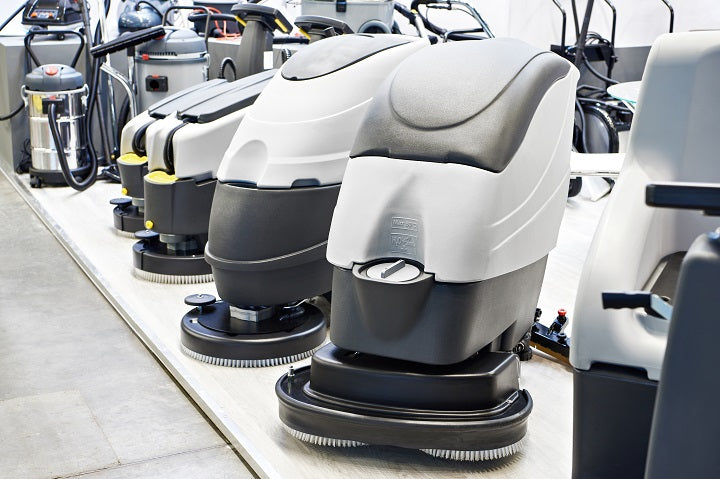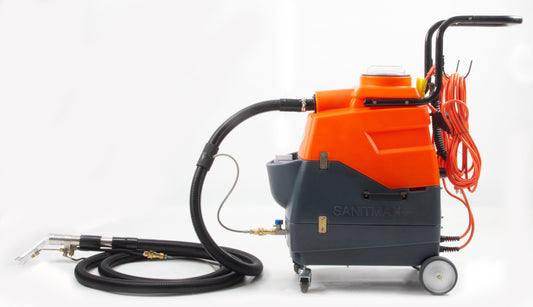Understanding the Basics of Floor Scrubbers
A floor scrubber, often called an auto scrubber or a rotary brush floor scrubber, is a mechanical device designed to clean floors efficiently. Unlike traditional cleaning methods that require mops and buckets, these machines clean and dry floors in a single operation, which makes them highly valued in environments where cleanliness and time efficiency are crucial. They are predominantly used in settings such as schools, hospitals, large retail spaces, and industrial facilities, where maintaining a clean floor is essential for safety and hygiene.
Automatic floor scrubbers come in various designs, but they share common components:
- Solution tank: Holds cleaning fluid.
- Scrub deck: Where the floor scrubber brushes or pads are attached.
- Recovery tank: Collects the dirty water after scrubbing.
These machines are powered by electricity, and some models feature batteries, making them mobile and easier to maneuver around large or obstructed areas. Their automated system reduces the physical strain on workers and increases the cleaning efficiency, allowing facilities to maintain high standards of cleanliness with less effort.
Types of Floor Scrubbers
When selecting a floor scrubber brush, understanding the types of floor scrubbers available is crucial. There are three main types:
1. Upright Scrubbers:
· Best for small, congested areas like classrooms and offices.
· Their compact design makes them easy to store.
· Ideal for quick cleaning tasks.
2. Walk-Behind Scrubbers:
· Suitable for medium to large areas like grocery stores.
· Offer a good balance between maneuverability and cleaning width.
· Some models come with features that reduce operator fatigue.
3. Ride-On Scrubbers:
· Designed for very large spaces such as warehouses and shopping malls.
· Allow the operator to sit and drive the machine, which is less tiring.
· Typically have the widest cleaning paths and largest capacity tanks.
Each type has specific advantages depending on the cleaning requirements and the size of the area to be cleaned. For example, upright scrubbers can easily reach tight spaces that larger machines cannot, while ride-on models cover large areas more quickly and with less operator fatigue.
The Role of Scrub Decks in Cleaning Performance
The scrub deck is a critical component of any floor scrubber, as it is directly involved in the cleaning process. There are three primary types of scrub decks, each with its own set of benefits depending on your cleaning needs:
-
Disc Decks:
- Use rotating pads or brushes.
- Effective for general cleaning and are easy to maintain.
- Best suited for smooth, flat surfaces.
-
Cylindrical Decks:
- Utilize rotating brushes to sweep and scrub at the same time.
- Eliminate the need for pre-sweeping.
- Ideal for rough or uneven surfaces with debris.
-
Oscillating Decks:
- Move in a rapid back-and-forth motion.
- Use less water and can reach into corners and edges more effectively.
- Great for removing tough stains and for chemical-free stripping.
Each type of deck works differently and can be more suitable for specific tasks. For instance, oscillating decks are highly effective for deep cleaning tasks where aggressive scrubbing is required, whereas disc decks are generally more versatile and easier for day-to-day maintenance.
Brushes vs. Pads
You have two main choices regarding the scrubbing element: brushes and pads. Each serves different floor types and cleaning intensities:
-
Brushes:
- Have bristles that reach into cracks and uneven surfaces.
- Can be made of various materials like nylon for delicate floors or grit-filled polypropylene for intense scrubbing.
- Typically, they last longer and are better for deep cleaning.
-
Pads:
- Are generally flat and best suited for smooth surfaces.
- Available in different abrasiveness levels, from soft polishing to aggressive stripping.
- Need to be replaced more frequently than brushes but are often less expensive.
The right tool depends on the floor type and the desired cleaning outcome. For example, brushes are more effective for textured surfaces such as concrete and tiles, where they can reach into pores and uneven areas. Pads are suitable for polished surfaces where a gentle but thorough cleaning is needed.
Types of Scrubbing Brushes
Exploring the types of scrubbing brushes further, it's clear that the material and design of the brush bristles are key to their effectiveness. For example, nylon brushes are soft and flexible, making them suitable for delicate surfaces that need a gentle touch to avoid scratches. These brushes are often used in retail environments or schools where the floor's appearance is important.
Polypropylene brushes are tougher and more suited for rough surfaces like concrete or outdoor areas requiring more aggressive cleaning. These brushes can withstand the rigors of removing tough dirt and debris without wearing down quickly. Gritted brushes, which incorporate elements like silicon carbide, provide a level of abrasiveness that is effective for stripping old finishes or deep cleaning very dirty floors. Choosing the right type of brush for your floor scrubber ensures that you are using the machine as effectively as possible, extending both the life of the machine and the cleanliness of your floors.
Applications and Settings for Different Brushes
Different settings require different types of floor machine scrubbing brushes. Understanding where each type excels can help you choose the most effective equipment for your needs:
-
Industrial Plants and Warehouses:
- Benefit from cylindrical brushes that can pick up debris while scrubbing.
- Heavy-duty grit brushes are ideal for removing tough grime embedded in concrete floors.
-
Hospitals and Schools:
- Need disc brushes for regular maintenance to keep surfaces free of dust and pathogens.
- Soft nylon brushes are preferred to prevent damage to delicate floors.
-
Retail and Grocery Stores:
- Require medium abrasiveness to handle high foot traffic without damaging floor finishes.
- Walk-behind scrubbers with disc decks are commonly used for their efficiency and ease of use.
The right floor scrubber brush can significantly enhance the cleaning capabilities of your machine, ensuring that you maintain a clean, safe, and welcoming environment for workers, customers, and visitors alike. Understanding these settings and applications will guide you in making an informed decision that matches your cleaning requirements.
Maintenance Tips for Scrubber Brushes
Good maintenance practices are essential to extend the life of your floor scrubber brushes and ensure they continue to perform at their best. Regularly cleaning your brushes to remove dirt, grime, and other residues will prevent them from becoming clogged, which can reduce their cleaning effectiveness. It’s also important to check the brushes for wear and replace them when necessary to avoid damage to your floors or the scrubber.
Additionally, proper storage of brushes when not in use is crucial. They should be kept in a clean, dry area to prevent mold growth and deterioration of the bristles. By taking good care of your brushes, you extend their lifespan and maintain the overall efficiency of your cleaning equipment.
When to Replace Your Scrubber Brushes
Knowing when to replace your scrubber brushes is key to optimal cleaning efficiency. Look for signs of wear, such as fraying bristles or uneven wear patterns, which can indicate it's time for a replacement. Most brushes will also have indicators, such as wear lines or measurements, to help you determine when they have reached the end of their useful life.
Regular inspections and timely replacements of worn brushes are crucial for preventing ineffective cleaning and potential damage to the floors. By staying vigilant and replacing brushes when needed, you ensure that your floor scrubber continues to operate effectively, keeping your premises clean and presentable.
In conclusion, selecting and maintaining the right floor scrubber brush is fundamental to achieving the best cleaning results. By understanding the various types of brushes available and their appropriate applications, you can optimize your cleaning processes and ensure your facility remains clean, safe, and well-maintained. Whether managing a small space or a large complex, the right brushes can significantly enhance your cleaning efficiency.





















